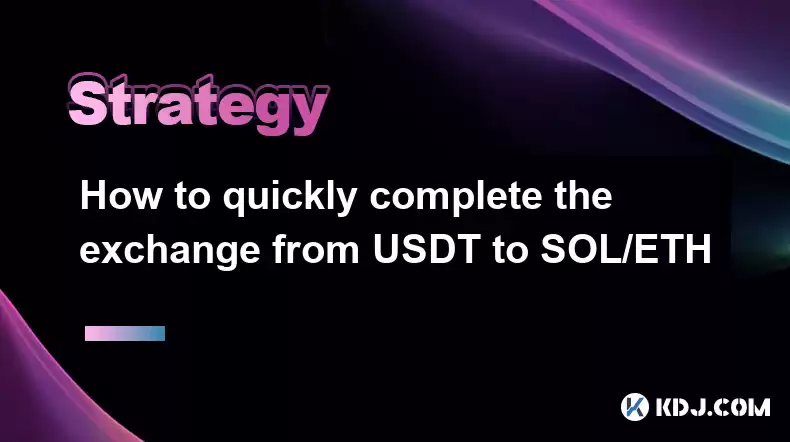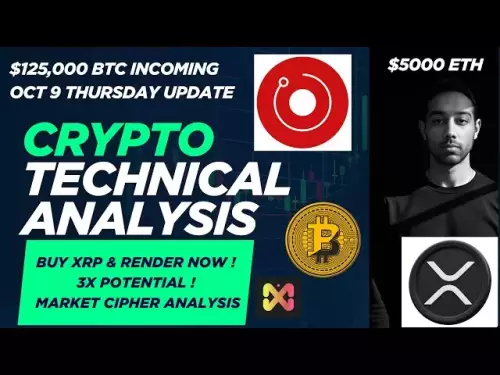-
 bitcoin
bitcoin $122659.385674 USD
0.52% -
 ethereum
ethereum $4484.113342 USD
-0.09% -
 bnb
bnb $1304.229256 USD
-0.85% -
 tether
tether $1.000204 USD
-0.03% -
 xrp
xrp $2.860636 USD
-0.51% -
 solana
solana $227.288799 USD
2.36% -
 usd-coin
usd-coin $0.999805 USD
0.01% -
 dogecoin
dogecoin $0.252837 USD
1.18% -
 tron
tron $0.341149 USD
1.12% -
 cardano
cardano $0.830507 USD
0.33% -
 hyperliquid
hyperliquid $45.792319 USD
0.04% -
 chainlink
chainlink $22.422164 USD
1.55% -
 ethena-usde
ethena-usde $1.000283 USD
0.01% -
 sui
sui $3.511389 USD
0.83% -
 stellar
stellar $0.385276 USD
-0.44%
How to quickly complete the exchange from USDT to SOL/ETH
To quickly exchange USDT for SOL/ETH, first understand the types of exchanges available, choose a reputable and secure platform, fund your account, place a limit or market order, and monitor the trade for successful completion and secure storage.
Dec 17, 2024 at 12:57 pm

How to Quickly Complete the Exchange from USDT to SOL/ETH
Key Points:- Understand different types of exchanges that support USDT to SOL/ETH exchange.
- Choose a reputable and secure exchange that suits your needs.
- Set up your account and complete the necessary verification steps.
- Fund your account with USDT and ensure it's available for trading.
- Place a limit order or market order to exchange USDT for SOL/ETH.
- Monitor your trade and withdraw or store your SOL/ETH securely.
Step 1: Understand Types of Exchanges
USDT to SOL/ETH exchange can be executed on various cryptocurrency exchanges:
- Centralized Exchanges (CEXs): Platforms like Binance, Coinbase, Kraken, and OKX offer a user-friendly interface, high liquidity, and support for multiple coins.
- Decentralized Exchanges (DEXs): Platforms like Uniswap, Sushiswap, and PancakeSwap allow peer-to-peer trading without intermediaries, providing anonymity and control.
- Peer-to-Peer (P2P) Exchanges: Platforms like LocalBitcoins and Paxful facilitate direct transactions between users, offering various payment options and pricing flexibility.
Step 2: Choose a Reputable Exchange
Select an exchange based on factors such as security, fees, liquidity, customer support, and the availability of SOL/ETH trading pairs. Consider reading reviews, checking exchange listings on aggregators like CoinMarketCap, and using trusted platforms recommended by experts.
Step 3: Set Up an Account
Follow the registration process to create an account on the chosen exchange. Provide accurate personal information, ensure strong password security, and complete the necessary identity and address verification steps.
Step 4: Fund Your Account
Deposit USDT into your exchange account using the supported methods, such as bank transfer, debit/credit card, or crypto transfers. Confirm the deposit and ensure that the USDT is available in your trading balance.
Step 5: Place an Order
Navigate to the SOL/ETH trading pair and choose between placing a limit order (specifying the desired price) or a market order (immediate execution at the current market price). Set the amount of USDT you wish to exchange and review the estimated exchange rate and fees.
Step 6: Monitor and Withdraw/Store
Once your trade is initiated, monitor its progress. Once completed, you can withdraw your SOL/ETH to a secure wallet or store it within the exchange's custody for future trading or asset management.
FAQs
Q: What are the fees associated with exchanging USDT to SOL/ETH?A: Exchanges typically charge trading fees, withdrawal fees, and sometimes deposit fees. These fees vary depending on the exchange, trading volume, and payment method.
Q: How long does it take to exchange USDT to SOL/ETH?A: The exchange time varies depending on the trading volume, network conditions, and the type of order placed. Market orders are generally executed instantly, while limit orders may take longer to fill.
Q: Can I exchange USDT to SOL/ETH using a mobile app?A: Yes, most centralized and decentralized exchanges offer mobile apps that allow users to trade from anywhere with an internet connection. Ensure to download the official app from trusted sources and enable appropriate security measures.
Disclaimer:info@kdj.com
The information provided is not trading advice. kdj.com does not assume any responsibility for any investments made based on the information provided in this article. Cryptocurrencies are highly volatile and it is highly recommended that you invest with caution after thorough research!
If you believe that the content used on this website infringes your copyright, please contact us immediately (info@kdj.com) and we will delete it promptly.
- CEA Industries & Jon Najarian: Bridging Traditional Finance with BNB
- 2025-10-09 21:05:16
- Binance Alpha's AB Token Crash: A Cautionary Tale in Cryptocurrency
- 2025-10-09 20:45:17
- Crypto Investors Embrace Stock-Picking: Bitwise CEO's Insight
- 2025-10-09 21:05:16
- Coinbase, Cruise, and Crypto Compliance: Navigating the Waters of Digital Finance
- 2025-10-09 21:10:12
- Crypto ETFs, Altcoins, and Wall Street: Navigating the New Frontier
- 2025-10-09 20:45:17
- Bitcoin's Decade of Dominance: A Super Reason to Hold for the Next 10 Years?
- 2025-10-09 20:25:15
Related knowledge

Practical parameter settings for a Bitcoin multi-timeframe moving average system
Sep 18,2025 at 10:54pm
Optimizing Timeframe Combinations for Bitcoin Trading1. Selecting appropriate timeframes is crucial when building a multi-timeframe moving average sys...

How can I filter out false breakouts in Dogecoin high-frequency trading?
Sep 22,2025 at 01:00am
Understanding False Breakouts in Dogecoin Trading1. A false breakout occurs when Dogecoin's price appears to move beyond a defined support or resistan...

Techniques for identifying tops and bottoms in the Bitcoin on-chain NVT model
Sep 20,2025 at 07:54pm
Understanding the NVT Model in Bitcoin Analysis1. The Network Value to Transactions (NVT) ratio is often described as the 'P/E ratio' of the cryptocur...

What does the surge in open interest in Bitcoincoin futures mean?
Sep 20,2025 at 11:18pm
Understanding the Surge in Dogecoin Futures Open Interest1. A surge in open interest within Dogecoin futures indicates a growing number of active cont...

How can I use the Ethereum USDT premium to gauge market sentiment?
Sep 18,2025 at 11:55pm
Understanding the Ethereum USDT Premium1. The Ethereum USDT premium refers to the price difference between USDT (Tether) traded on Ethereum-based plat...

What should I do if Ethereum staking yields decline?
Sep 20,2025 at 06:18am
Understanding the Causes Behind Declining Ethereum Staking Yields1. The Ethereum network transitioned to a proof-of-stake consensus mechanism with the...

Practical parameter settings for a Bitcoin multi-timeframe moving average system
Sep 18,2025 at 10:54pm
Optimizing Timeframe Combinations for Bitcoin Trading1. Selecting appropriate timeframes is crucial when building a multi-timeframe moving average sys...

How can I filter out false breakouts in Dogecoin high-frequency trading?
Sep 22,2025 at 01:00am
Understanding False Breakouts in Dogecoin Trading1. A false breakout occurs when Dogecoin's price appears to move beyond a defined support or resistan...

Techniques for identifying tops and bottoms in the Bitcoin on-chain NVT model
Sep 20,2025 at 07:54pm
Understanding the NVT Model in Bitcoin Analysis1. The Network Value to Transactions (NVT) ratio is often described as the 'P/E ratio' of the cryptocur...

What does the surge in open interest in Bitcoincoin futures mean?
Sep 20,2025 at 11:18pm
Understanding the Surge in Dogecoin Futures Open Interest1. A surge in open interest within Dogecoin futures indicates a growing number of active cont...

How can I use the Ethereum USDT premium to gauge market sentiment?
Sep 18,2025 at 11:55pm
Understanding the Ethereum USDT Premium1. The Ethereum USDT premium refers to the price difference between USDT (Tether) traded on Ethereum-based plat...

What should I do if Ethereum staking yields decline?
Sep 20,2025 at 06:18am
Understanding the Causes Behind Declining Ethereum Staking Yields1. The Ethereum network transitioned to a proof-of-stake consensus mechanism with the...
See all articles


























![🚨IS VECHAIN (VET) A DEAD COIN ?? PRICE ANALYSIS [GET READY NOW] 🚨IS VECHAIN (VET) A DEAD COIN ?? PRICE ANALYSIS [GET READY NOW]](/uploads/2025/10/09/cryptocurrencies-news/videos/vechain-vet-dead-coin-price-analysis-ready/68e7b200b067b_image_500_375.webp)















































